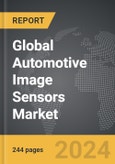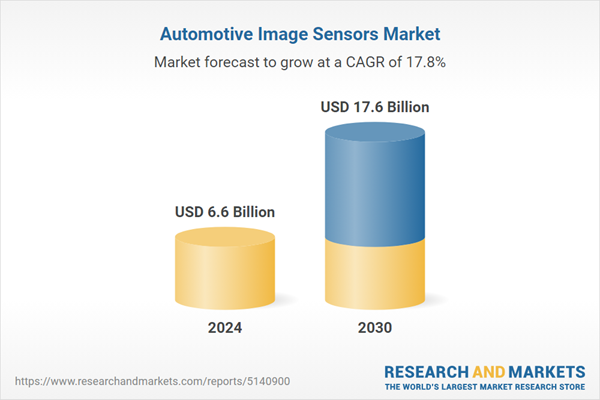The global market for Automotive Image Sensors was valued at US$6.6 Billion in 2024 and is projected to reach US$17.6 Billion by 2030, growing at a CAGR of 17.8% from 2024 to 2030. This comprehensive report provides an in-depth analysis of market trends, drivers, and forecasts, helping you make informed business decisions.
Global Automotive Image Sensors Market - Key Trends and Drivers Summarized
How Do Automotive Image Sensors Enhance Vehicle Safety and Performance?
Automotive image sensors have become a cornerstone of modern vehicle safety and performance, playing a critical role in enabling advanced driver-assistance systems (ADAS) and autonomous driving technologies. These sensors capture visual information from the vehicle's surroundings, which is then processed by the vehicle's electronic systems to detect obstacles, lane markings, pedestrians, and other vehicles. The data generated by image sensors allows for real-time analysis and decision-making, enabling features such as automatic emergency braking, lane-keeping assistance, and adaptive cruise control. The precision and reliability of image sensors are paramount, as they must operate effectively in a wide range of lighting conditions, including low-light and night-time environments. As the push for higher levels of vehicle autonomy continues, the demand for high-resolution and high-dynamic-range image sensors is growing, ensuring that vehicles can perceive and interpret their surroundings with greater accuracy and speed, thus enhancing overall safety and performance on the road.What Technological Innovations Are Shaping the Evolution of Automotive Image Sensors?
The automotive image sensor landscape is rapidly evolving, driven by technological innovations that are enhancing their capabilities and expanding their applications. One of the most significant advancements is in Complementary Metal-Oxide-Semiconductor (CMOS) technology, which has led to the development of smaller, more energy-efficient, and higher-resolution sensors. These improvements are crucial for integrating multiple image sensors into vehicles without compromising space or power consumption, which is especially important as automakers look to implement 360-degree vision systems and other multi-camera setups. Additionally, innovations in sensor fusion technology, where data from image sensors is combined with information from other sensors such as radar and lidar, are enabling more robust and reliable perception systems. This fusion allows for more accurate environmental mapping and object detection, even in challenging conditions like heavy rain or fog. Furthermore, the integration of artificial intelligence (AI) into image processing is transforming how vehicles interpret visual data, enabling more sophisticated features such as gesture recognition and driver monitoring systems. These technological advancements are not only enhancing the functionality of automotive image sensors but also paving the way for their use in increasingly autonomous vehicles.How Are Automotive Image Sensors Expanding Their Role Beyond Traditional Applications?
While automotive image sensors have traditionally been associated with external applications like parking assistance and collision avoidance, their role within vehicles is expanding rapidly. In-cabin monitoring systems, which use image sensors to track driver attention, detect drowsiness, and monitor passenger safety, are becoming increasingly common as automakers focus on enhancing the in-vehicle experience and safety. These systems rely on high-precision image sensors to capture detailed images and interpret subtle changes in facial expressions or eye movements, ensuring that the vehicle can respond appropriately to potential safety risks. Moreover, image sensors are integral to the development of augmented reality (AR) displays in vehicles, which overlay digital information onto the real-world view to assist drivers with navigation and other tasks. The growing importance of vehicle-to-everything (V2X) communication, where vehicles exchange information with other vehicles and infrastructure, is also driving the adoption of image sensors that can capture and process environmental data in real-time, facilitating safer and more efficient traffic management. As vehicles become more connected and intelligent, the applications of automotive image sensors are expanding, making them a vital component in the future of mobility.What Are the Key Factors Driving Growth in the Automotive Image Sensor Market?
The growth in the automotive image sensor market is driven by several factors that are fundamentally transforming the automotive industry. A significant driver is the increasing adoption of advanced driver-assistance systems (ADAS) and autonomous driving technologies, which rely heavily on high-quality image sensors for accurate environmental perception. The rise of electric and hybrid vehicles, with their emphasis on advanced safety features and energy-efficient technologies, is also contributing to the demand for innovative image sensors. Additionally, the growing consumer expectation for enhanced vehicle safety and connectivity is pushing automakers to integrate more sophisticated image sensors into their designs. Technological advancements, such as the development of AI-enhanced image processing and sensor fusion, are expanding the functionality of image sensors, making them indispensable in modern vehicles. Moreover, stringent government regulations mandating advanced safety systems in vehicles are propelling the adoption of image sensors across various vehicle segments. As the automotive industry continues to evolve towards more autonomous and connected vehicles, the market for automotive image sensors is poised for robust growth, driven by these technological and regulatory factors.Report Scope
The report analyzes the Automotive Image Sensors market, presented in terms of market value (US$ Thousand). The analysis covers the key segments and geographic regions outlined below.Segments
Technology (ADAS, Driver Support System, Autonomy); End-Use (Passenger Cars, Commercial Vehicles).Geographic Regions/Countries
World; United States; Canada; Japan; China; Europe (France; Germany; Italy; United Kingdom; Spain; Russia; and Rest of Europe); Asia-Pacific (Australia; India; South Korea; and Rest of Asia-Pacific); Latin America (Argentina; Brazil; Mexico; and Rest of Latin America); Middle East (Iran; Israel; Saudi Arabia; United Arab Emirates; and Rest of Middle East); and Africa.Key Insights:
- Market Growth: Understand the significant growth trajectory of the ADAS Technology segment, which is expected to reach US$8.2 Billion by 2030 with a CAGR of a 19.2%. The Driver Support System Technology segment is also set to grow at 16.3% CAGR over the analysis period.
- Regional Analysis: Gain insights into the U.S. market, valued at $1.7 Billion in 2024, and China, forecasted to grow at an impressive 23.0% CAGR to reach $4.6 Billion by 2030. Discover growth trends in other key regions, including Japan, Canada, Germany, and the Asia-Pacific.
Report Features:
- Comprehensive Market Data: Independent analysis of annual sales and market forecasts in US$ Million from 2024 to 2030.
- In-Depth Regional Analysis: Detailed insights into key markets, including the U.S., China, Japan, Canada, Europe, Asia-Pacific, Latin America, Middle East, and Africa.
- Company Profiles: Coverage of major players such as OmniVision Technologies, Inc., ON Semiconductor Corporation, Pixelplus Co., Ltd., Samsung Electronics Co., Ltd., Sony Corporation and more.
- Complimentary Updates: Receive free report updates for one year to keep you informed of the latest market developments.
Why You Should Buy This Report:
- Detailed Market Analysis: Access a thorough analysis of the Global Automotive Image Sensors Market, covering all major geographic regions and market segments.
- Competitive Insights: Get an overview of the competitive landscape, including the market presence of major players across different geographies.
- Future Trends and Drivers: Understand the key trends and drivers shaping the future of the Global Automotive Image Sensors Market.
- Actionable Insights: Benefit from actionable insights that can help you identify new revenue opportunities and make strategic business decisions.
Key Questions Answered:
- How is the Global Automotive Image Sensors Market expected to evolve by 2030?
- What are the main drivers and restraints affecting the market?
- Which market segments will grow the most over the forecast period?
- How will market shares for different regions and segments change by 2030?
- Who are the leading players in the market, and what are their prospects?
Some of the 42 major companies featured in this Automotive Image Sensors market report include:
- OmniVision Technologies, Inc.
- ON Semiconductor Corporation
- Pixelplus Co., Ltd.
- Samsung Electronics Co., Ltd.
- Sony Corporation
- STMicroelectronics
Table of Contents
I. METHODOLOGYII. EXECUTIVE SUMMARY2. FOCUS ON SELECT PLAYERSIII. MARKET ANALYSISSOUTH KOREAREST OF ASIA-PACIFICARGENTINABRAZILMEXICOREST OF LATIN AMERICAIRANISRAELSAUDI ARABIAUNITED ARAB EMIRATESREST OF MIDDLE EASTIV. COMPETITION
1. MARKET OVERVIEW
3. MARKET TRENDS & DRIVERS
4. GLOBAL MARKET PERSPECTIVE
UNITED STATES
CANADA
JAPAN
CHINA
EUROPE
FRANCE
GERMANY
ITALY
UNITED KINGDOM
SPAIN
RUSSIA
REST OF EUROPE
ASIA-PACIFIC
AUSTRALIA
INDIA
LATIN AMERICA
MIDDLE EAST
AFRICA
Companies Mentioned (Partial List)
A selection of companies mentioned in this report includes, but is not limited to:
- OmniVision Technologies, Inc.
- ON Semiconductor Corporation
- Pixelplus Co., Ltd.
- Samsung Electronics Co., Ltd.
- Sony Corporation
- STMicroelectronics
Table Information
| Report Attribute | Details |
|---|---|
| No. of Pages | 244 |
| Published | March 2025 |
| Forecast Period | 2024 - 2030 |
| Estimated Market Value ( USD | $ 6.6 Billion |
| Forecasted Market Value ( USD | $ 17.6 Billion |
| Compound Annual Growth Rate | 17.8% |
| Regions Covered | Global |









